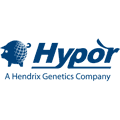 In Germany, where loose housing systems are legally mandated, pig temperament is extremely important in a successful herd. Mr. Macke and his son know the importance of this trait all too well. Together they run a 400 sow, farrow to feeder farm; they work on a 2-week batch system, with a 21-day lactation length. The Macke farm has been a partner of Hypor on the dam line since 2011 and has loose housed their pigs during gestation since 2012. Mr. Macke was able to talk to us a little bit about his experience in group housing and his advice for producers looking to switch to this system.
In Germany, where loose housing systems are legally mandated, pig temperament is extremely important in a successful herd. Mr. Macke and his son know the importance of this trait all too well. Together they run a 400 sow, farrow to feeder farm; they work on a 2-week batch system, with a 21-day lactation length. The Macke farm has been a partner of Hypor on the dam line since 2011 and has loose housed their pigs during gestation since 2012. Mr. Macke was able to talk to us a little bit about his experience in group housing and his advice for producers looking to switch to this system.
What have you noticed about any changes in the animals and your way of working in a loose housing system?

The animals seem much better adapted to this system. They were not bad before, but the additional movement reduces the losses due to lameness. There has not been a decrease in the farrowing rate, nor is it more work than before. The only thing we’ve had to change how we manage the animals. It is important to keep a close eye and act faster when issues arise.
How do you put the groups together? Condition or parity?
Mainly by physical body condition, then by parity. First litter sows and gilts are always kept separately. Sows are mixed into their groups right after weaning to re-establish the hierarchy and help stimulate and detect heat.
Which feeding system do you use?
In one of the barns, there are 3 feeders per group of 25 animals, where we use an ad libitum feeding strategy. In the other groups, we work with limit feeding and feeding the sows 2 times a day. Rather than feeding once in the morning and afternoon, like most do, instead, we give a first feed in the morning and a second feeding in the late morning.
Structural constraints in the building mean that there are a few different sizes of groups. Ideally, I’d like to have groups of more than 100 animals with a modern sow feeding system.
What do you notice most about the Libra*, especially with regard to group housing?
The sows are calm and balanced in the group. They have good foot and leg structure, with very little lameness or lesions. Teat and udder quality remains, even after many parities.
I’ve also noticed that the Hypor Libra* distinguishes herself by farrowing many large and healthy piglets, especially when the Hypor Maxter is used on the sire line. The sows rarely need assistance during farrowing.
What advice would you give to a fellow producer who is making a change to group housing?
I would recommend everyone who switches to loose housing in gestation not only to gather information, but they should also visit other farms to see how they operate. Everybody has to find out for themselves which system works best since there is no one size fits all solution. Find a system that works best for your unique needs.
Any final thoughts on using the Hypor Libra* in group housing?
To sum up? “Go for it!” I’ve been very happy with her performance and stayability in the herd. In group housing, she is a natural fit.

The easy transition of the Libra* is partially thanks to Hypor’s breeding program, where all dam line sows around the world are kept in loose housing during gestation. By doing this, Hypor is able to select sows that will perform well in group housing. A great deal of success can be attributed to the dedication and expertise of our customers, like Mr. Macke and his son. All the best as you continue on your path to success!
Contact your local Hypor representative to learn more about the Hypor Libra* and how we can help you succeed.
September 23, 2020 - Hypor



